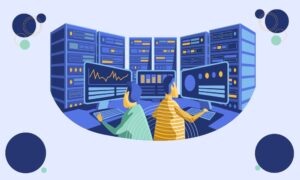We all want the information we need to choose the right job and prepare ourselves for it, but real life is not always a linear path—and that’s one of the things that makes it very enjoyable. In addition, new sectors and job lines are constantly developing with the rapid speed of technological development. As Data Science is a high-growth, demand-driven vocation with excellent employment prospects, it is an excellent time to examine whether it is the appropriate career to become a Data Scientist.
In the course of becoming a full-fledged Data Scientist, there are several ways you can learn Data Science online, from a distance, and with great ease! A wide range of courses will help you properly learn Data Science and grasp its fundamental concepts without much effort.
Let’s clarify what a Data Scientist does before examining what skills you need to become a Data Scientist with no job experience.
What is a Data Scientist?
Data Scientists gather and purge massive quantities of data, maintain user-friendly dashboards and databases, analyse data to resolve problems, conduct research, create algorithms, and provide stakeholders with exceptional insights.
Nowadays, there are numerous reasons to pursue a Data Science career: a high wage, a somewhat steady employment market, increasing growth even amid a global recession, and fascinating solutions to issues in many sectors.
Is Data Science hard?
It depends on your background and whether you love dealing with statistics and figures. While Data Scientists don’t need as much software or machine learning as data engineers, they must learn how to code to create predictive models.
Data Science has a sharp learning curve with complex issues, extensive data, technique skills, and domain knowledge. Fortunately, there are plenty of free online tools to assist you in starting as a Data Scientist at the entry-level.
Do you need to have a degree in Data Science?
No. Without an advanced degree or even a Bachelor’s degree, you may learn Data Science. Although the demand for Data Scientists is much higher than the supply, and the vast majority of posts require a Master’s or PhD in engineering, computer science, maths, or statistics, organisations have the capacity to recruit non-traditional candidates. Many leading businesses, such as Google, Apple, and IBM, no longer need college qualifications for candidates.
You may attend online courses or certification programs or teach yourself through videos and modules if you want to enter Data Science without a degree.
Below you can discover six steps without prior expertise to break into Data Science.
Step 1: Polish your mathematical abilities
Data Science should be an easy transition if you come from a quantitative background. It would help if you went to the basics for the data analysis, starting with the graph data points along the X and Y axes and discovering links and patterns between different variables before evaluating data using high-tech instruments.
Here are some recommended math topics for mastering to ensure that you can create effective code and draw exact conclusions:
- Statistical methods and probability theory
- Probability distributions
- Multivariable calculus
- Linear algebra
- Hypothesis testing
- Statistical modelling and fitting
- Data summaries and descriptive statistics
- Regression analysis
- Bayesian thinking and modelling
- Markov chains
Step 2: Learn a language (or two) for programming
In comparison to other areas of employment, Data Science focuses more on what you know and how effectively you can demonstrate your relevant abilities and less on your alma mater’s status. The interview process is predicated on the power of persons from various backgrounds to level the playing field.
Once you have a solid mathematical basis, you may begin to use a handful of the necessary programs for aspiring Data Scientists: SQL, R, Python, and SAS. Below is the introduction to understand which language to prioritise:
- Python is a library scripting language that allows you to articulate, filter, and convert extensive data and unstructured information. Python offers web development, software development, profound learning, and computer learning applications. It is the Data Scientist’s most commonly utilised tool.
- R is a free-form, sophisticated mathematical and statistical programming language. It also permits the visualisation of data and has a significant supporting community.
- SQL is a relationship management technique via which numerous tables and databases may query and connect data.
- SAS is a premium tool for the statistical analysis, business intelligence, and prediction analysis utilised by major companies. However, it is not recommended to people because of the costs. You may take up SAS on the job if you study the other languages.
Step 3: Take internship projects or on side projects
Companies desire to have a working experience to strengthen their curriculum vitae. You may use your competency set in real-world conditions and obtain feedback in real-time as you start growing your knowledge base.
You may seek part-time or internships through social media and work boards on freelancing sites, such as Upwork or Fiverr. Kaggle provides monetary reward tournaments as well.
Show examples of prior work on Github, LinkedIn, or a personal web page to establish a robust online presence and an excellent portfolio.
Without experience, it might be challenging to obtain experience, but by utilising online networks and starting small, you can establish that you have everything to make Data Science expertise measurable.
Step 4: Begin as a data analyst
Data Scientists and data analysts are not the same, although both are prominent professional choices.
Data analysts oversee the collecting of data and discover trends in datasets.
- In addition to interpreting data, Data Scientists utilise their coding and modelling abilities.
- Data analyst posts can be more easily broken as a first job and can be an essential starting point for a career in Data Science.
Step 5: Work hard—and network harder
Knowing other scientists is the greatest method to learn about different job options and perhaps even meet future members of your team. You may also find out what sort of firm you want to work for, what projects are of interest to you (size, industry, culture), and how to prepare for the employment application.
It is easier to break into smaller firms when starting without expertise, but larger companies in the IT industry, with enterprise programs, may provide greater training and mentorship facilities.
Another great possibility is to go from another role in your organisation to Data Science. If you are in excellent standing, you may often start networking internally and investigate the chance to fulfil the technical criteria by interviewing a Data Scientist team.
You can locate the discussions that pick up your interest in particular jobs when you set up virtual coffee chats and phone calls. This opens the door to request tailored references from your network. Careerbuilder reports that 82 per cent of businesses ranked referrals as the most significant return and that many organisations encourage employers to seek new talent by giving financial bonuses.
Step 6: Tell the potential companies about your career change
Data Science is very multidisciplinary, and not all previous information will most likely be lost. Data researchers need to have a direct commercial influence on their models. Although you should focus on Data Science in your curriculum vs cover letter, you should include prior positions in which you have utilisedcan or improved Microsoft Excel, communication, and cooperation.
Conclusion:
Include a summary on your resume to explain your transformation, use Data Science keywords, or list courses such as the Data Science and analytics courses you have taken, technical languages you have learned, or any project work you have undertaken to illuminate your expansion in Data Science. Keep in mind that developing these crucial skills is made simple through the range of on-demand, certification Data Science courses on Great learning. Simply log in, learn, and kick start your lucrative career!

















